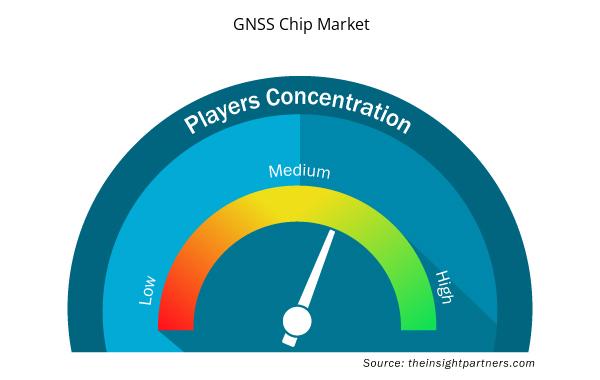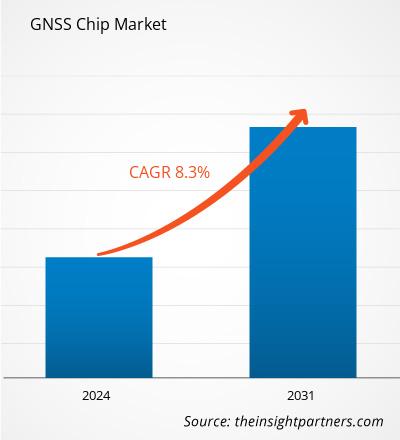GNSS 芯片市场规模预计将从 2024 年的 52.4 亿美元增至 2031 年的 91.7 亿美元。预计 2024-2031 年期间市场复合年增长率将达到 8.3%。GNSS 在 UGV 和 UAV 中的应用可能会在未来几年为市场带来新的趋势。
GNSS芯片市场分析
GNSS 用户期望近乎即时的定位;然而,要实现这一点需要至少四颗卫星的信号,这可能需要几分钟或几小时,甚至在信号条件差或极端环境下会失败。将 GNSS 数据与移动网络信息相结合可以增强各种物联网应用的性能。随着越来越多的消费产品融入导航和定位功能,对低功耗 GNSS 芯片的需求预计将上升。目前,技术先进的可穿戴设备(如健身带和智能手表)需求旺盛。GNSS 芯片广泛用于这些设备,以便在用户跑步、散步或开车时提供准确的位置信息。
GNSS 芯片市场概况
全球导航卫星系统 (GNSS) 是一个卫星网络,它将定位和计时数据传输到接收器,接收器将这些数据与传感器输入相结合,以计算位置、速度和高度。GNSS 芯片的精度取决于可见卫星的数量和信号质量。因此,一些政府正试图部署区域星座来改善导航和测绘。中国、俄罗斯、美国、印度、日本和欧盟都开发并投入使用了自己的 GNSS 解决方案,在全球市场上提供了具有竞争力的替代方案。
定制此报告以满足您的需求
您可以免费定制任何报告,包括本报告的部分内容、国家级分析、Excel 数据包,以及为初创企业和大学提供优惠和折扣
GNSS 芯片市场:

- 获取此报告的关键市场趋势。这个免费样品将包括数据分析,从市场趋势到估计和预测。
GNSS 芯片市场驱动因素和机遇
5G 网络和高速互联网需求不断增长
5G 网络提供更快的数据速度和更低的延迟,这使得 GNSS 芯片能够提供更准确和实时的位置数据,从而使导航和地图绘制等应用受益。由于这些关键优势,对基于位置的服务 (LBS) 的需求正在增加。全球导航卫星系统 (GNSS) 一直是用户设备精确定位的来源,因为该系统能够使蜂窝通信为移动网络运营商提供各种确定用户位置的方法。许多移动网络运营商已宣布在城市地区部署 5G 网络。2024 年 2 月,Vodafone Idea (Vi) 宣布了在印度推出 5G 服务的项目,预计该服务将在未来 6-7 个月内在该国推出。该公司计划覆盖 17 个关键地区的 75 个主要城市,重点关注数据需求量大的城市和工业区。2023 年 4 月,该电信公司为其在墨西哥的 6800 万预付费用户推出了 5G 服务,将 5G 的好处扩展到超过 8000 万 Telcel 客户。由于 5G 基站数量的增加,对更高级别的定时精度的要求也在增加,以确保 5G 网络上的稳定连接。Quectel L26-T 模块可以提供 6.8 纳秒的定时精度,并满足 5G 网络的严格定时同步要求。因此,对 5G 网络和高速互联网的不断增长的需求极大地推动了 GNSS 芯片市场的增长。
物联网技术在自动驾驶汽车中的应用日益增多
物联网技术创造了先进的解决方案,例如高级驾驶辅助系统 (ADAS)、联网汽车解决方案、车载信息娱乐系统以及导航和远程信息处理解决方案。导航系统主要部署在车辆中,用于跟踪目的并显示提供有关速度、位置、方向、附近街道和兴趣点的信息的地图。支持物联网的汽车集成了 GNSS 芯片,可帮助驾驶员高效驾驶,有关机构可以在紧急情况下跟踪他们的位置。2023 年 10 月,u-blox 推出了车辆定位安全解决方案 u-safe,以加速自动驾驶汽车的采用。u-safe 使用经过验证的汽车导航组件为一级供应商和 OEM 提供可靠的 ADAS 定位解决方案。此外,2021 年 1 月,高通技术公司和阿尔卑斯阿尔派株式会社宣布推出一款名为 ViewPose 的基于摄像头的传感和定位设备,以支持绝对车道级车辆定位。FocalPoint 提供创新的 S-GNSS 自动定位技术,为汽车原始设备制造商 (OEM) 提供更高的 GNSS 定位可靠性和准确性。此外,由于定位和传感器集成技术的进步,自动驾驶汽车的想法正在成为现实。全自动驾驶汽车需要准确的定位解决方案才能正常行驶。高精度 GNSS 技术提供了关键优势,包括自动驾驶汽车所需的可靠性、准确性和精确度。因此,对支持物联网的汽车的需求增长预计将在未来几年为GNSS 芯片市场创造增长机会。
GNSS 芯片市场报告细分分析
有助于得出 GNSS 芯片市场分析的关键部分是设备、应用和垂直。
- 根据设备,GNSS 芯片市场分为智能手机、平板电脑、个人导航设备、车载系统等。2024 年,智能手机市场占据主导地位。
- 根据应用,GNSS 芯片市场细分为导航和基于位置的服务、地图和测量、远程信息处理、计时和同步等。导航和基于位置的服务领域在 2024 年占据市场主导地位。
- 根据垂直行业,GNSS 芯片市场细分为消费电子、汽车和运输、军事和国防、海洋等。消费电子领域在 2024 年占据市场主导地位。
GNSS 芯片市场份额(按地区)分析
- GNSS 芯片市场分为五大区域:北美、欧洲、亚太地区 (APAC)、中东和非洲 (MEA) 以及南美和中美。
- 亚太地区对 GNSS 芯片的需求受到该地区重要制造商的推动。在亚太地区,主要的消费电子制造商专注于开发创新产品,这些产品需要使用智能手机、可穿戴设备和平板电脑等设备记录位置和实时数据以进行跟踪。可穿戴设备的日益普及和亚太地区消费电子领域的持续技术进步推动了 GNSS 芯片市场的增长。此外,该地区的几家公司正在推出卫星定位芯片。例如,2023 年 12 月,专注于固定宽带网络基础设施和先进物联网人工智能的 Airoha Technology 推出了 AG3335MA 卫星定位芯片系列。该系列通过了针对汽车应用的 AEC-Q100 2 级可靠性资格测试。此外,该公司将该系列芯片与其母公司联发科及其 Dimensity 汽车平台集成在一起,为全球汽车制造商提供高度集成的解决方案和技术测试服务。
GNSS 芯片市场区域洞察
Insight Partners 的分析师已详细解释了预测期内影响 GNSS 芯片市场的区域趋势和因素。本节还讨论了北美、欧洲、亚太地区、中东和非洲以及南美和中美洲的 GNSS 芯片市场细分和地理位置。

- 获取 GNSS 芯片市场的区域特定数据
GNSS 芯片市场报告范围
| 报告属性 | 细节 |
|---|---|
| 2024 年的市场规模。 | 52.4 亿美元 |
| 2031 年市场规模 | 91.7亿美元 |
| 全球复合年增长率(2024 - 2031) | 8.3% |
| 史料 | 2021-2023 |
| 预测期 | 2024-2031 |
| 涵盖的领域 | 按设备
|
| 覆盖地区和国家 | 北美
|
| 市场领导者和主要公司简介 |
|
GNSS 芯片市场参与者密度:了解其对业务动态的影响
GNSS 芯片市场正在快速增长,这得益于终端用户需求的不断增长,而这些需求又源于消费者偏好的不断变化、技术进步以及对产品优势的认识不断提高等因素。随着需求的增加,企业正在扩大其产品范围,进行创新以满足消费者的需求,并利用新兴趋势,从而进一步推动市场增长。
市场参与者密度是指在特定市场或行业内运营的企业或公司的分布情况。它表明在给定市场空间中,相对于其规模或总市场价值,有多少竞争对手(市场参与者)存在。
在 GNSS 芯片市场运营的主要公司有:
- 高通公司
- 移远通信股份有限公司
- 博通公司
- 塞普滕特里奥 NV
- 天宝公司
- 古野电气株式会社
免责声明:上面列出的公司没有按照任何特定顺序排列。

- 获取 GNSS 芯片市场顶级关键参与者概览
GNSS 芯片市场新闻和最新发展
GNSS 芯片市场通过收集一手和二手研究后的定性和定量数据进行评估,其中包括重要的公司出版物、协会数据和数据库。下面列出了 GNSS 芯片市场的一些发展情况:
- Septentrio 宣布推出 AntaRx-Si3。这是市场上第一款采用超坚固外壳的 GNSS/INS(惯性导航系统)智能天线,旨在轻松安装在农业机器人等机器上。AntaRx-Si3 是利用 GNSS/INS FUSE+ 技术的接收器系列的新成员,旨在满足恶劣工业环境中定位可用性的需求,在这些环境中,GNSS 信号接收可能会暂时受到影响,例如在树叶下。FUSE+ 中的 IMU 传感器还提高了定位完整性和可靠性,这对自主系统至关重要。(来源:Septentrio NV,新闻稿,2024 年 2 月)
- Trimble 推出了 Trimble MPS566 模块化 GNSS 航向接收器,这是一款下一代全球导航卫星系统 (GNSS) 接收器,专为打桩作业、钻井和海洋建筑而设计。MPS566 集成了双 GNSS 天线端口和与星座无关的 Trimble ProPoint 技术,可为需要精确航向的任务提供准确的位置和方向。(来源:u-blox Holding AG,新闻稿,2023 年 11 月)
GNSS 芯片市场报告覆盖范围和交付成果
“GNSS 芯片市场规模和预测(2021-2031 年)”对市场进行了详细的分析,涵盖了以下领域:
- GNSS 芯片市场规模及全球、区域和国家层面所有主要细分市场的预测
- GNSS 芯片市场趋势以及驱动因素、限制因素和关键机遇等市场动态
- 详细的 PEST 和 SWOT 分析
- GNSS 芯片市场分析涵盖主要市场趋势、全球和区域框架、主要参与者、法规和最新市场发展
- 行业格局和竞争分析,涵盖市场集中度、热图分析、知名参与者以及 GNSS 芯片市场的最新发展
- 详细的公司简介
- 历史分析(2 年)、基准年、预测(7 年)及复合年增长率
- PEST 和 SWOT 分析
- 市场规模价值/数量 - 全球、区域、国家
- 行业和竞争格局
- Excel 数据集


- Third Party Logistics Market
- Nuclear Waste Management System Market
- Online Recruitment Market
- Wheat Protein Market
- Oxy-fuel Combustion Technology Market
- Energy Recovery Ventilator Market
- Single-Use Negative Pressure Wound Therapy Devices Market
- Smart Grid Sensors Market
- Thermal Energy Storage Market
- Predictive Maintenance Market

Report Coverage
Revenue forecast, Company Analysis, Industry landscape, Growth factors, and Trends

Segment Covered
This text is related
to segments covered.

Regional Scope
North America, Europe, Asia Pacific, Middle East & Africa, South & Central America

Country Scope
This text is related
to country scope.
常见问题
The global GNSS chip market was estimated to be US$ 5.24 billion in 2024 and is expected to grow at a CAGR of 8.3% during the forecast period 2025 – 2031.
The global GNSS chip market is expected to reach US$ 9.17 billion by 2031.
The incremental growth expected to be recorded for the global GNSS chip market during the forecast period is US$ 3.92 billion.
Application of GNSS in UGVs and UAVs is anticipated to play a significant role in the global GNSS chip market in the coming years.
The key players holding majority shares in the global GNSS chip market are Qualcomm Inc, Broadcom Inc, Septentrio NV, Trimble Inc, Furuno Electric Co Ltd, MediaTek Inc, STMicroelectronics NV, Skyworks Solutions Inc, u-blox Holding AG, and Quectel Wireless Solutions Co Ltd.
Rising demand for 5G network and high-speed internet; increasing use of GNSS chips in consumer electronic devices; and surging need for accuracy in real-time data are the major factors that propel the global GNSS chip market.
Trends and growth analysis reports related to Electronics and Semiconductor : READ MORE..
The List of Companies - GNSS Chip Market
- Qualcomm Inc
- Quectel Wireless Solutions Co Ltd
- Broadcom Inc
- Septentrio NV
- Trimble Inc
- Furuno Electric Co Ltd
- MediaTek Inc
- STMicroelectronics NV
- Skyworks Solutions Inc
- u-blox Holding AG
The Insight Partners performs research in 4 major stages: Data Collection & Secondary Research, Primary Research, Data Analysis and Data Triangulation & Final Review.
- Data Collection and Secondary Research:
As a market research and consulting firm operating from a decade, we have published and advised several client across the globe. First step for any study will start with an assessment of currently available data and insights from existing reports. Further, historical and current market information is collected from Investor Presentations, Annual Reports, SEC Filings, etc., and other information related to company’s performance and market positioning are gathered from Paid Databases (Factiva, Hoovers, and Reuters) and various other publications available in public domain.
Several associations trade associates, technical forums, institutes, societies and organization are accessed to gain technical as well as market related insights through their publications such as research papers, blogs and press releases related to the studies are referred to get cues about the market. Further, white papers, journals, magazines, and other news articles published in last 3 years are scrutinized and analyzed to understand the current market trends.
- Primary Research:
The primarily interview analysis comprise of data obtained from industry participants interview and answers to survey questions gathered by in-house primary team.
For primary research, interviews are conducted with industry experts/CEOs/Marketing Managers/VPs/Subject Matter Experts from both demand and supply side to get a 360-degree view of the market. The primary team conducts several interviews based on the complexity of the markets to understand the various market trends and dynamics which makes research more credible and precise.
A typical research interview fulfils the following functions:
- Provides first-hand information on the market size, market trends, growth trends, competitive landscape, and outlook
- Validates and strengthens in-house secondary research findings
- Develops the analysis team’s expertise and market understanding
Primary research involves email interactions and telephone interviews for each market, category, segment, and sub-segment across geographies. The participants who typically take part in such a process include, but are not limited to:
- Industry participants: VPs, business development managers, market intelligence managers and national sales managers
- Outside experts: Valuation experts, research analysts and key opinion leaders specializing in the electronics and semiconductor industry.
Below is the breakup of our primary respondents by company, designation, and region:

Once we receive the confirmation from primary research sources or primary respondents, we finalize the base year market estimation and forecast the data as per the macroeconomic and microeconomic factors assessed during data collection.
- Data Analysis:
Once data is validated through both secondary as well as primary respondents, we finalize the market estimations by hypothesis formulation and factor analysis at regional and country level.
- Macro-Economic Factor Analysis:
We analyse macroeconomic indicators such the gross domestic product (GDP), increase in the demand for goods and services across industries, technological advancement, regional economic growth, governmental policies, the influence of COVID-19, PEST analysis, and other aspects. This analysis aids in setting benchmarks for various nations/regions and approximating market splits. Additionally, the general trend of the aforementioned components aid in determining the market's development possibilities.
- Country Level Data:
Various factors that are especially aligned to the country are taken into account to determine the market size for a certain area and country, including the presence of vendors, such as headquarters and offices, the country's GDP, demand patterns, and industry growth. To comprehend the market dynamics for the nation, a number of growth variables, inhibitors, application areas, and current market trends are researched. The aforementioned elements aid in determining the country's overall market's growth potential.
- Company Profile:
The “Table of Contents” is formulated by listing and analyzing more than 25 - 30 companies operating in the market ecosystem across geographies. However, we profile only 10 companies as a standard practice in our syndicate reports. These 10 companies comprise leading, emerging, and regional players. Nonetheless, our analysis is not restricted to the 10 listed companies, we also analyze other companies present in the market to develop a holistic view and understand the prevailing trends. The “Company Profiles” section in the report covers key facts, business description, products & services, financial information, SWOT analysis, and key developments. The financial information presented is extracted from the annual reports and official documents of the publicly listed companies. Upon collecting the information for the sections of respective companies, we verify them via various primary sources and then compile the data in respective company profiles. The company level information helps us in deriving the base number as well as in forecasting the market size.
- Developing Base Number:
Aggregation of sales statistics (2020-2022) and macro-economic factor, and other secondary and primary research insights are utilized to arrive at base number and related market shares for 2022. The data gaps are identified in this step and relevant market data is analyzed, collected from paid primary interviews or databases. On finalizing the base year market size, forecasts are developed on the basis of macro-economic, industry and market growth factors and company level analysis.
- Data Triangulation and Final Review:
The market findings and base year market size calculations are validated from supply as well as demand side. Demand side validations are based on macro-economic factor analysis and benchmarks for respective regions and countries. In case of supply side validations, revenues of major companies are estimated (in case not available) based on industry benchmark, approximate number of employees, product portfolio, and primary interviews revenues are gathered. Further revenue from target product/service segment is assessed to avoid overshooting of market statistics. In case of heavy deviations between supply and demand side values, all thes steps are repeated to achieve synchronization.
We follow an iterative model, wherein we share our research findings with Subject Matter Experts (SME’s) and Key Opinion Leaders (KOLs) until consensus view of the market is not formulated – this model negates any drastic deviation in the opinions of experts. Only validated and universally acceptable research findings are quoted in our reports.
We have important check points that we use to validate our research findings – which we call – data triangulation, where we validate the information, we generate from secondary sources with primary interviews and then we re-validate with our internal data bases and Subject matter experts. This comprehensive model enables us to deliver high quality, reliable data in shortest possible time.

 获取此报告的免费样本
获取此报告的免费样本